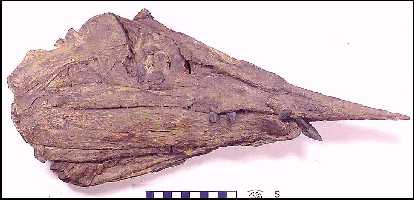 |
About Oceans of
Kansas Paleontology
Copyright © 1996-2010 by Mike Everhart
Last revised 02/14/2010
Published on the Internet since December, 1996
LEFT: A right-side
view of the skull of Protosphyraena nitida, an extinct swordfish-like fish from
the Late Cretaceous Smoky Hill Chalk. Click here to go to the Protosphyraena
webpage. |
While a name like "Oceans of Kansas Paleontology" may seem a little
unusual since Kansas is about as far away as you get from an ocean, the whole Midwest
region of North America, from the Arctic Circle to the Gulf of Mexico, has actually been
underwater for far longer than it has been above it. It has only been in the last 65
million years or so that Kansas has been above sea level and relatively dry. The major
continental uplift that created the Rocky Mountains also raised what is now the Plains
States half a mile or more from what had been the floor of a shallow inland sea.
I put Oceans of Kansas Paleontology on the Internet in December of 1996,
largely because I could not find this kind of information anywhere on the Web. After
learning enough HTML code to become dangerous, I put the first few pages up on the web and
created the beginnings of a monster web site that has grown steadily ever since. As of
January, 2008, after more than 11 years on the Internet, Oceans of Kansas Paleontology has
over 250 pages up and running... and continues to grow. The idea for the first book came
about as the result of a number of requests that I received from people who had enjoyed
the website and wanted to buy the book... Of course, there wasn't any book at that time,
but I started thinking about it. When I approached the Indiana University Press
about idea, they were very enthusiastic.... so here we are, 20 months later and
almost 6000 books sold! After that, National Geographic needed a book to go along with the
IMAX 3-D movie called Sea
Monsters. I was fortunate enough to be one of the science advisers on the movie
and also got to write the book!
| The Smoky Hill Chalk Formation that is exposed in Western Kansas
has been the source of some of the best Cretaceous marine fossils that have been found
anywhere in the world, It has been extensively collected for almost 130 years,
starting with the the late 1860s work of Professor B. F. Mudge,
and the discoveries of Professor Marsh's Yale College Expeditions in
1870. Even after millions of years of uplift and erosion, there are still thousands of
feet of marine sediments (shale, chalk, limestone, sandstone) under the soils of the
State. The oldest of these sedimentary rocks (found in extreme southeast Kansas) date back
almost half a BILLION years to the Mississippian Period. Most of the
Kansas fossils that we work with are from the Smoky Hill Chalk and Pierre Shale. They are
the remains of extinct animals that lived in the Late Cretaceous Period (87-75 million
years ago), and were buried at the bottom of in a shallow marine (salt water) sea. |
 |
See our latest Permian Shark
discovery HERE ... over 280 million years old! from a different ocean that once
covered Kansas.
Want to find sharks teeth? Look what Kansas has to
offer: Kansas Sharks Teeth
| Mike and Pam Everhart at the site of Pam's 1988 discovery of the
skull of a large, late Cretaceous fish called Protosphyraena nitida. Protosphyraena
was a primitive predatory fish that looked something like a modern swordfish, but the vertebrae and
ribs are poorly ossified and rarely are preserved as fossils. They do have a distinctive bone at the base of the tail (caudal fin) called the hypural.
To date, this is the only known specimen of Protosphyraena which has the pectoral
fins preserved with a complete skull. The specimen was donated to the Los Angeles County
Museum of Natural History and a picture of the right side of the prepared skull was
published in the LACMNH Magazine, TERRA, in 1993 (Vol. 31, Number 4). A cast
of the skull was last seen in the Denver Museum of Natural History, in the Ray Troll traveling exhibit. Pictures of a cast of the
LACM 129752 skull are HERE and HERE. See our Protosphyraena
page HERE. |
 |
Mike and Pam Everhart collect fossils from the Late Cretaceous Smoky Hill Chalk
Member (Niobrara Formation) and Pierre Shale of western Kansas. Mike was appointed
(8/98) as an Adjunct Curator of Paleontology at the Sternberg Museum of Natural History, Fort Hays
State University, Hays, Kansas and is an active member of the Society of Vertebrate
Paleontology. He is also the President (2005) of the Kansas Academy of Science, and has organized the
Paleontology Symposium at the last seven annual meetings of the KAS. He is now the editor
of the Transactions of the Kansas
Academy of Science, a 135+ year old scientific journal. We have been collecting
fossils in the Smoky Hill chalk for almost 20 years and have donated several unique and
interesting specimens to museums across the United States. In addition, Mike writes papers, leads field trips, gives school talks, runs
this webpage, and works with paleontologists from around the world. Although we collect
all kinds of marine fossils from the Smoky Hill chalk, we are particularly interested in
large marine reptiles called mosasaurs and plesiosaurs. Much of the information presented on this web site
is about these fascinating animals and their connections to other marine life of the time.
A list of our abstracts / papers are
here






